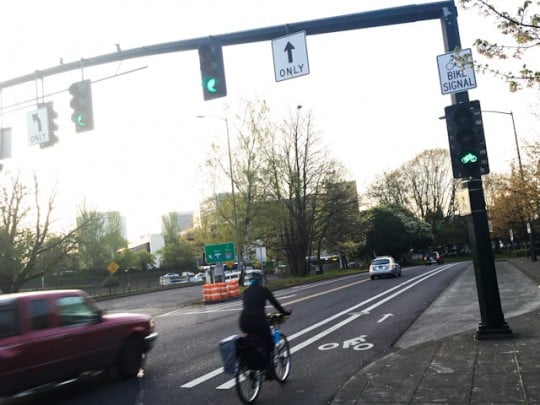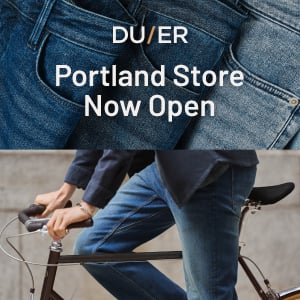
(Photo: J.Maus/BikePortland)
One of Portland’s busiest bike crossings will flow a little more efficiently thanks to a new bike signal activated last Thursday.
The signal gives a green light to people biking southbound on Wheeler Avenue, preparing to curve around the Moda Center into the Rose Quarter Transit Center area. Northbound bus and bike traffic here has a green signal phase of its own, but that doesn’t conflict with southbound bike traffic.
Now that the bike-specific traffic signal is installed, people can bike both north and south during that signal phase. Here’s the description from Peter Koonce, signals division manager at the Portland Bureau of Transportation:
I had wanted to do it this from my first day at the City, but there’s a lot of things like that. So, the story goes that [local traffic analyst] Kirk Paulsen reminded me of this. When a citizen asks for something, the City (with appropriate policies and resources: money, time, and expertise) has an ability to respond. In this case, I had an intern draw up the plans and get it to the hands of the electricians who do the construction work.
The signal is a simple addition that will reduce delay. The added green time for the southbound bike lane allows people on bikes to go through when the northbound bus/bike only movement is green. Previously, we treated each direction (north, south, eastbound) as separate movements because of the heavy left turn conflict of cars trying to get on the freeway. The southbound bicycle lane does not conflict with the northbound bus/bike movement.
Advertisement
Koonce said the project cost about $5,000. The new signal phase adds about 12 to 15 seconds of southbound green time, depending on the time of day and amount of northbound traffic detected.
Koonce said the project actually includes at least two violations of the national standards for bike-specific signals, which are widely used in Europe but still considered “experimental” in the United States. The new signal violates two rules, he says:
– First, the bike signal is positioned too close to the main traffic signal, leading to a risk that people in cars will see the bike signal and think it’s for them. Koonce said Portland addressed this by inserting metal bars in the signal head that make the signal invisible to people in the rightmost mixed-traffic lane.
– Second, the bike signal isn’t allowed to be green in any situation where there’s a potential conflict from any direction, such as eastbound cars turning right from Winning onto Wheeler. Koonce said this didn’t seem to be a major risk in this situation.
“I don’t think a lot of people leaving the Moda Center are circulating around the Moda Center,” Koonce said. Still, he said the issue might be worth more investigation.
Koonce, who sits on the national board that oversees traffic signal regulations (where he’s generally been an outvoted voice for change) said the national signal standards had been written “to be as conservative as possible” to prevent “overuse of bike signals.”
He said Portland had installed the bike signal anyway.
“It seemed like a good idea,” he said.


